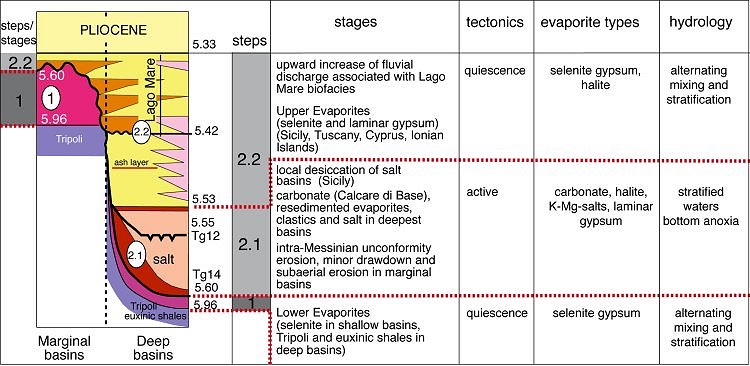 New consensus on Messinian Salinity Crisis – CIESM Workshop 331 New consensus on Messinian Salinity Crisis – CIESM Workshop 331
21 February 2008, CIESM News
The Messinian Salinity Crisis (MSC) is widely regarded as one of the most dramatic episodes of oceanic change of the past 20 million years. It occured some 6 million years ago, when vast amounts of evaporite salt were deposited in the Mediterranean area, leading to a significant drop in Global Ocean salinity. This event left indelible signs in the present terrestrial and marine physical landscape through the accumulation of large volumes of evaporitic rocks, mainly gypsum and halite. Since their discovery in the deep basin in the early 1970s, contrasting hypotheses have been expressed on the origin of their formation, ranging from a huge marine cascade at Gibraltar falling into a fully dessicated Mediterranean basin, to a tectonically-controlled repetitively isolated, dessicated and refilled basin. In the absence of conclusive data from the deep(est) Mediterranean basins, the MSC remained a very contentious event, fueling much research and fierce controversies in the past two decades.
Hoping to break away from this trench war, CIESM (the Mediterranean Science Commission) invited international specialists of various disciplines for a brainstorming workshop1 in late 2007 in Almeria. Encouraged to pass by the usual controversies and focus on potential topics of consensus, the participants came up with a fascinating new consensus report (800 Ko - PDF format), and agreed on a possible new MSC scenario envisaging three successive stages of development, accurately dated in an astrochronological time frame (see illustration below).
 A new MSC scenario. A new MSC scenario.
During the first MSC stage, between 5.96 and 5.6 million years ago, evaporitic conditions started to develop in small, shallow-water embayments of the Mediterranean basin’s margins. In such conditions gypsum did accumulate, now largely outcropping in Spain, Italy, Crete and Cyprus and known as “Lower Evaporites”. It is still difficult to tell what actually happened in deeper-water environments; a conclusive answer can probably only be exacted when the deep basin sequences will be cored through their base by proposed IODP drillings.
In the second MSC stage, which lasted only 50,000 years between 5.6 and 5.55 million years ago, the ocean connections were severely reduced by the combined effects of tectonic uplift in the Atlantic gateways area and world sea-level fall during a glacial phase. These factors triggered the MSC acme, characterized by evidence for a substantial evaporative sea-level drop (probably in the order of several hundreds meters) in the whole Mediterranean basin with subaerial exposure and erosion of the margins, and deposition of primary evaporites (mainly halite and potash salts) in deep basins.
During the third and last MSC stage (between 5.55 and 5.33 million years ago) the Mediterranean basin area, almost totally disconnected from the Atlantic Ocean, experienced a rapid transition to brackish/fresh water environments, known as “Lago Mare” and similar to the present-day Caspian Sea. Evaporitic conditions periodically developed in deep and in shallow settings, mainly in southern and eastern Mediterranean areas, leading to the formation of the so called “Upper Evaporites”. The synchronous return to fully marine conditions and thus the end of the MSC, occurred 5.33 million years ago, at the base of the Pliocene series, due to the opening of the Strait of Gibraltar and the re-establishment of normal water exchanges with the Atlantic Ocean.
The integration of data from several scientific disciplines led furthermore to the astounding conclusion that the Messinian salt layers show high intrinsic dynamics. Several salt layers start to creep laterally during the precipitation phase even without external forcing. This finding is of major importance for the hydrocarbon industry, since more than half of the world’s hydrocarbon reservoirs are related to salt structures. Inclusions in evaporites are considered to contain ice-core-like microbial and environmental archives recording paleo-environmental cycles. Last but not least, the salinar fluids and the accompanying nutrient flux strongly influence the biological habitat above and beneath the salt. The observation that fluids may flow through or out of the Messinian Salt may have a major impact on any geotechnical usage of salt caverns, e.g. their usage as waste repository.
Obviously this new MSC scenario will orient future research activities, in the context of international, interdisciplinary programs, to test several key questions that still remain outstanding. An enormous breakthrough can definitely be expected once the deep basin sequences will be cored to their base.
Workshop participants:
Josefa Antón, Namik Çağatay, Gert J. De Lange, Rachel Flecker, Virginie Gaullier, Nina Gunde – Cimerman, Christian Hübscher, Wout Krijgsman, Piet Lambregts, Johanna Lofi, Stefano Lugli, Vinicio Manzi, Terry J. McGenity, Marco Roveri, Francisco J. Sierro and Jean-Pierre Suc.
1 CIESM, 2008. The Messinian Salinity Crisis from mega-deposits to microbiology – A consensus report.
N° 33 in CIESM Workshop Monographs [F. Briand, ed.], 168 pages, Monaco.
Download the PDF file (Warning: this material is protected by international copyright law)
|



